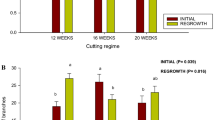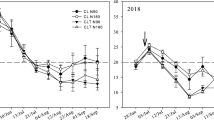Abstract
Inadequate nutrition limits small-scale livestock production by smallholder farmers in South Africa but can be addressed by the introduction of woody fodder species. Cutting woody plants to harvest fodder affects their productivity and thus it is necessary to determine the optimum cutting height. Cutting affects the productivity and survival of woody plants because it alters concentrations of non-structural carbohydrates, which are used to support their recovery. Since pigeon pea (Cajanus cajan (L.) Millsp.) is not widely grown in South Africa and is not managed as a pruned hedgerow, there was a need to investigate the effect of cutting height under local conditions, especially in areas that experience frost. The trial was established in November 2016, ran over two growing seasons (2016/2017 and 2017/2018) and concluded in August 2018. The treatments comprised three silvopastoral systems with Panicum maximum planted between pigeon pea hedgerows that were cut at 60 cm and 90 cm above the ground, or left uncut and sole P. maximum. Over the two year period, the pigeon pea plants cut at 90 cm above ground produced significantly more leaf, twig and total biomass than the plants cut at 60 cm. Cutting height also had a significant effect on the percentage twig, with pigeon pea plants cut at 90 cm having significantly higher percentage twig than those cut at 60 cm (P < 0.05). There was a significant effect of cutting height on stem sugar concentration and sugar: starch ratio but not for starch and total non-structural carbohydrate concentration (P > 0.05). In July 2018 there were a number of days with temperatures below 0 °C. Prior to this no mortalities had been observed, but the frost events resulted in die-off. The mortality rates were determined in August 2018 when it was clear which of the shrubs had clearly died. The shrub mortality rates were higher for pruned relative to unpruned shrubs, but the effect was not significant (P > 0.05). It was concluded that the choice of cutting height is important for maximising browse production. Future research should consider the effect of pruning on non-structural carbohydrate concentration and total pool in the roots to better understand the reasons for reduced production and shrub mortalities.

Similar content being viewed by others
Availability of data and material
Data generated during the current study are available from the corresponding author on reasonable request.
References
Agyare WA, Kombiok JM, Karbo N, Larbi A (2002) Management of pigeon pea in short fallows for crop-livestock production systems in the Guinea savanna zone of northern Ghana. Agroforest Syst 54:197–202
Aswanimiyuni A, Noor M, Haryani H, Norfadzrin F, Nurzillag M (2018) A comparison of feed intake and growth performance of goats fed guinea grass and Napier grass. Malays J Vet Res 9:13–18
Ates S, Cicek H, Bell LW, Norman HC, Mayberry DE, Kassam S, Hannaway DB, Louhaichi M (2018) Sustainable development of smallholder crop-livestock farming in developing countries. Earth Environ Sci 142:012076
Buthelezi LS, Mupangwa JF, Muchenje V, Nherera-Chokuda FV (2018) Influence of drying technique on chemical composition and ruminal degradability of subtropical Cajanus cajan L. Anim Nutr 5:95–100
Castro M, Fernández-Núñunez E (2016) General aspects of silvopastoral systems. In: Fernández-Núñunez E, Castro M (eds) Management of agroforestry systems: ecological, social and economic approaches. Instituto Politécnico de Bragança, Portugal, pp 1–16
Chesney P, Vasques N (2007) Dynamics of non-structural carbohydrate reserves in pruned Erythrina poeppigiana and Gliricidia sepium trees. Agrofor Syst 69:89–105
Chesney P (2008) Nitrogen and fine root length dynamics in a tropical agroforestry system with periodically pruned Erythrina poeppigiana. Agrofor Syst 72:149–159
Deslauriers A, Caron L, Rossi S (2015) Carbon allocation during defoliation: testing defense-growth trade-off in balsam fir. Front Plant Sci 6:338
Dietz MC, Sala A, Carbone MS, Czimczik CI, Mantooth JA, Richardson AD, Vargas R (2014) Nonstructural carbon in woody plants. Ann Rev Plant Biol 65:67–87
Edvan RL, de Carneiro MSS, Magalhães JA, Albuquerque DR, de Silva MSM, Bezerra LR, Oliveira RL, Santos EM (2014) The forage yield of during the rainy and dry seasons following pruning management in Brazil. Cienc Investig Agrar 41:309–316
Fabunmi TO, Adigbo SO, Odedina JN (2010) Effect of severity of pruning on growth, yield and survivability of pigeon pea (Cajanus cajan) in pigeon pea/pepper alley cropping. J Agr Sci Environ 10:18–26
Fadiyimu AA, Fajemisin AN, Alokan JA, Aladesanwa RD (2011) Effect of cutting regimes on seasonal fodder yields of Moringa oleifera in the tropical rainforest of Nigeria. Livestock Res Rural Dev 23:article #27
Furze ME, Huggett BA, Aubrecht DM, Stolz CD, Carbone MS, Richardson AD (2019) Whole-tree nonstructural carbohydrate storage and seasonal dynamics in five temperate species. New Phytol 221:1466–1477
Galiano L, Martínez-Vilalta LF (2011) Carbon reserves and canopy defoliation determine the recovery of Scots pine 4 years after a drought episode. New Phytol 190:750–759
Hoffman WA, Flake SW, Abreu RCR, Pilon NAL, Rossatto DR, Durigan G (2018) Rare frost events reinforce tropical savanna-forest boundaries. J Ecol 107:468–477
Holdo RM (2007) Elephants, fire, and frost can determine community structure and composition in Kalahari woodlands. Ecol Appl 17:558–568
Kaur K, Saini KS (2018) Productivity of pigeon pea (Cajanus cajan L.) under different row spacing and genotypes. Int J Curr Microbiol Appl Sci 7:942–946
Khan AU, Sharif F, Hamza A (2016) Establishing a baseline on the distribution and pattern of occurrence of Salvadora persica L. with meteorological data and assessing its adaptation in the adjacent warmed-up zones. Int J Biometeorol 60:1897–1906
Landhausser SM (2011) Aspen shoots are carbon autonomous during bud break. Trees 25:531–536
Landhausser SM, Lieffers VJ (2012) Defoliation increases risk of carbon starvation in root systems of mature aspen. Trees 26:653–661
Larbi A, Awojiede AA, Adekunle IO, Ladipo DO, Akinlade JA (2000) Fodder production responses to pruning height and fodder quality of some trees and shrubs in a forest-savanna transition zone in southwestern Nigeria. Agrofor Syst 48:157–168
Latt CR, Nair PKR, Kang BT (2000) Interactions among cutting frequency, reserve carbohydrates, and post-cutting biomass production in Gliricidia sepium and Leucaena leucocephala. Agrofor Syst 50:27–46
Liu W, Su J, Li S, Land X, Huang X (2017) Non-structural carbohydrates regulated by season and species in the subtropical monsoon broadleaved evergreen forest of Yunnan Province. China Sci Rep 8:1083
Loreti F, Pasani PL (1990) Structural manipulation for improved performance in woody plants. Hort Sci 25:64–70
Maguire AJ, Kobe RK (2015) Drought and shade deplete nonstructural carbohydrate reserves in seedlings of five temperate tree species. Ecol Evol 5:5711–6572
Makhubedu T, Letty BA, Mafongoya P, Scogings PF (2019) The influence of pruning height on symbiotic nitrogen fixation in a tree-based fodder production system. Afr J Range For Sci 36:197–201
Martínez-Vilalta J, Sala A, Asensio D, Galiano L, Hoch G, Palacio S, Piper FI, Lloret F (2016) Dynamics of non-structural carbohydrates in terrestrial plants: a global synthesis. Ecol Monogr 86:495–516
Mathews C, Saxena K B (2005) Prospects for pigeonpea cultivation in drought-prone areas of South Africa. In: proceedings of the first international edible legume conference in conjunction with the IVth World Cowpea Congress, 17–21 April 2005, Durban, South Africa
Mbomi SE, Adetimirin VO, Ogungbesan AM, Anjah GM (2012) Fodder production: response to sowing dates, pruning heights and cutting intervals of Tephrosia species in the western highlands of Cameroon. J Environ Iss Agr Dev Countr 4:65–70
Moyo H, Scholes MC, Twine W (2015) The effects of repeated cutting on coppice response of Terminalia sericea. Trees 29:161–169
Musokwa M, Mafongoya P, Lorentz S (2019) Evaluation of agroforestry systems for maize (Zea mays) productivity in South Africa. S Afr J Plant Soil 36:65–67
Newell EA, Mulkey SS, Wright JS (2002) Seasonal patterns of carbohydrate storage in four tropical tree species. Oecologia 131:333–342
Nzunda E, Griffiths M, Lawes M (2008) Sprouting by remobilization of above-ground resources ensures persistence after disturbance of coastal dune forest trees. Funct Ecol 22:577–582
Patidar M, Mathus BK (2016) Enhancing forage production through a silvi-pastoral system in an arid environment. Agrofor Syst 91:713–727
Paula S, Ojeda F (2009) Belowground starch consumption after recurrent severe disturbance in three resprouter species of the genus Erica. Botany 87:253–259
Poorter L, Kitajima K (2007) Carbohydrate storage and light requirements of tropical moist and dry forest tree species. Ecology 88:1000–1011
Ramírez-Briones E, Rodríguez-Macías R, Salcedo-Pérez E, Martínez-Gallardo N, Tiessen A, Molina-Torres J, Délano-Frier JP, Zañudo-Hernández J (2017) Seasonal variation in non-structural carbohydrates, sucrolytic activity and secondary metabolites in deciduous and perennial Diospyros species sampled in Western Mexico. PLoS ONE 12:e0187235
Ranganathan R, de Wit CT (2015) Mixed cropping of annual and woody perennial species. In: Ong CK, Black C, Wilson J (eds) Tree-crop interactions: agroforestry in a changing climate. CABI, Wallingford, UK, pp 24–40
Richardson AD, Carbone MS, Keenan TF, Czimczik CI, Hollinger DY, Murakami P, Schaberg PG, Xu X (2013) Seasonal dynamics and age of stemwood nonstructural carbohydrates in temperate forest trees. New Phytol 197:850–861
Rosas T, Galiano L, Ogaya R, Peñuelas J, Martínez-Vivalta J (2013) Dynamics of non-structural carbohydrates in three Mediterranean woody species following long-term experimental drought. Front Plant Sci 4:400
Saxena KB, Choudhary AK, Saxena RK, Varshney RK (2018) Breeding pigeonpea cultivars for intercropping: synthesis and strategies. Breed Sci 68:159–167
Singh YP, Singh S (2018) Impact of mitigation technologies on rainy season pulse crops from climatic abnormalities. Indian Farm 68:69–74
Singh YP, Singh S, Nanda P, Singh AK (2018) Impact of establishment techniques and maturity duration of pigeon pea cultivars on yield, water productivity and properties of soil. Agr Res 7:271–279
Siriri D, Ong CK, Wilson J, Boffa JM, Black CR (2010) Tree species and pruning regime affect crop yield on bench terraces in SW Uganda. Agrofor Syst 78:65–77
Thalmann M, Santelia D (2017) Starch as a determinant of plant fitness under abiotic stress. New Phytol 214:943–951
Tomlinson KW, van Langevelde F, Ward D, Bongers F, da Silva DA, Prins HHT, de Bie S, Sterck FJ (2013) Deciduous and evergreen trees differ in juvenile biomass allometries because of differences in allocation to root storage. Ann Bot 112:575–587
Würth MKR, Peláez-Riedl S, Wright SJ, Körner C (2005) Non-structural carbohydrate pools in a tropical forest. Oecologia 143:11–24
Yadav A, Gendley MK, Sahu J, Patel PK, Chandraker K, Dubey A (2019) Silvopastoral system: a prototype of livestock agroforestry. Pharma Innov J 8(2):76–82
Acknowledgements
This study was funded by the Water Research Commission (WRC) of South Africa under project number K5/2492//4 (Water use of agroforestry systems for food, forage and/or biofuel production). The authors are also thankful to the management of Fountainhill Estate for providing a research site for the trials.
Funding
BAL and TM were supported by project K5/2492//4 (Water use of agroforestry systems for food, forage and/or biofuel production) of the Water Research Commission (WRC) of South Africa.
Author information
Authors and Affiliations
Contributions
All authors contributed to conceptualization and experimental design. BA Letty and T Makhubedu collected the data. BA Letty managed the project, analysed the data and wrote the first draft. All authors contributed to revisions.
Corresponding author
Ethics declarations
Conflicts of interest
The authors declare no conflict of interest.
Additional information
Publisher's Note
Springer Nature remains neutral with regard to jurisdictional claims in published maps and institutional affiliations.
Rights and permissions
About this article
Cite this article
Letty, B.A., Makhubedu, T., Scogings, P.F. et al. Effect of cutting height on non-structural carbohydrates, biomass production and mortality rate of pigeon peas. Agroforest Syst 95, 659–667 (2021). https://doi.org/10.1007/s10457-021-00616-8
Received:
Accepted:
Published:
Issue Date:
DOI: https://doi.org/10.1007/s10457-021-00616-8




